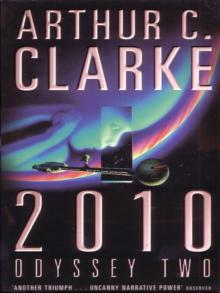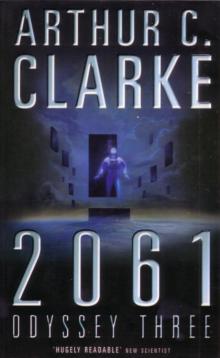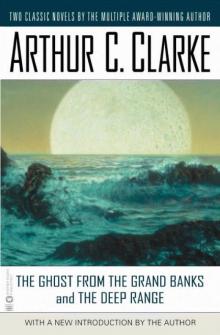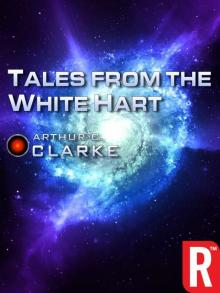- Home
- Arthur C. Clarke
A Fall of Moondust
A Fall of Moondust Read online
A FALL OF MOONDUST
Arthur C. Clarke
Science Fiction Masterworks Volume 49
eGod
CONTENTS
Title Page
Contents
Chapter 1
Chapter 2
Chapter 3
Chapter 4
Chapter 5
Chapter 6
Chapter 7
Chapter 8
Chapter 9
Chapter 10
Chapter 11
Chapter 12
Chapter 13
Chapter 14
Chapter 15
Chapter 16
Chapter 17
Chapter 18
Chapter 19
Chapter 20
Chapter 21
Chapter 22
Chapter 23
Chapter 24
Chapter 25
Chapter 26
Chapter 27
Chapter 28
Chapter 29
Chapter 30
Chapter 31
About the Author
TO LIZ AND MIKE
CHAPTER ONE
To be the skipper of the only boat on the Moon was a distinction that Pat Harris enjoyed. As the passengers filed aboard Selene, jockeying for window seats, he wondered what sort of trip it would be this time. In the rear-view mirror he could see Miss Wilkins, very smart in her blue Lunar Tourist Commission uniform, putting on her usual welcome act. He always tried to think of her as “Miss Wilkins,” not Sue, when they were on duty together; it helped to keep his mind on business. But what she thought of him, he had never really discovered.
There were no familiar faces; this was a new bunch, eager for their first cruise. Most of the passengers were typical tourists—elderly people, visiting a world that had been the very symbol of inaccessibility when they were young. There were only four or five passengers on the low side of thirty, and they were probably technical personnel on vacation from one of the lunar bases. It was a fairly good working rule, Pat had discovered, that all the old people came from Earth, while the youngsters were residents of the Moon.
But to all of them, the Sea of Thirst was a novelty. Beyond Selene’s observation windows, its gray, dusty surface marched onward unbroken until it reached the stars. Above it hung the waning crescent Earth, poised forever in the sky from which it had not moved in a billion years. The brilliant, blue-green light of the mother world flooded this strange land with a cold radiance—and cold it was indeed, perhaps three hundred below zero on the exposed surface.
No one could have told, merely by looking at it, whether the Sea was liquid or solid. It was completely flat and featureless, quite free from the myriad cracks and fissures that scarred all the rest of this barren world. Not a single hillock, boulder, or pebble broke its monotonous uniformity. No sea on Earth—no millpond, even—was ever as calm as this.
It was a sea of dust, not of water, and therefore it was alien to all the experience of men; therefore, also, it fascinated and attracted them. Fine as talcum powder, drier in this vacuum than the parched sands of the Sahara, it flowed as easily and effortlessly as any liquid. A heavy object dropped into it would disappear instantly, without a splash, leaving no scar to mark its passage. Nothing could move upon its treacherous surface except the small, two-man dust-skis—and Selene herself, an improbable combination of sledge and bus, not unlike the Sno-cats that had opened up the Antarctic a lifetime ago.
Selene’s official designation was Dust-Cruiser, Mark I, though to the best of Pat’s knowledge, a Mark II did not exist even on the drawing board. She was called “ship,” “boat,” or “moon bus,” according to taste; Pat preferred “boat,” for it prevented confusion. When he used that word, no one would mistake him for the skipper of a spaceship—and spaceship captains were, of course, two a penny.
“Welcome aboard Selene,” said Miss Wilkins, when everyone had settled down. “Captain Hams and I are pleased to have you with us. Our trip will last four hours, and our first objective will be Crater Lake, a hundred kilometers east of here, in the Mountains of Inaccessibility
Pat scarcely heard the familiar introduction; he was busy with his count-down. Selene was virtually a grounded spaceship; she had to be, since she was traveling in a vacuum, and must protect her frail cargo from the hostile world beyond her walls. Though she never left the surface of the Moon, and was propelled by electric motors instead of rockets, she carried all the basic equipment of a full-fledged ship of space—and all of it had to be checked before departure.
Oxygen—O.K. Power—O.K. Radio—O.K. (“Hello, Rainbow Base, Selene testing. Are you receiving my beacon?”) Inertial navigator—zeroed. Air-lock safety—On. Cabin-leak detector—O.K. Internal lights—O.K. Gangway—disconnected. And so on for more than fifty items, every one of which would automatically call attention to itself in case of trouble. But Pat Harris, like all spacemen hankering after old age, never relied on autowamings if he could carry out the check himself.
At last he was ready. The almost silent motors started to spin, but the blades were still feathered, and Selene barely quivered at her moorings. Then he eased the port fan into fine pitch, and she began to curve slowly to the right. When she was clear of the embarkation building, he straightened her out and pushed the throttle forward.
She handled very well, when one considered the complete novelty of her design. There had been no millennia of trial and error here, stretching back to the first neolithic man who ever launched a log out into a stream. Selene was the very first of her line, created in the brains of a few engineers who had sat down at a table and asked themselves: “How do we build a vehicle that will skim over a sea of dust?”
Some of them, harking back to Ole Man River, had wanted to make her a stern-wheeler, but the more efficient submerged fans had carried the day. As they drilled through the dust, driving her before them, they produced a wake like that of a high-speed mole, but it vanished within seconds, leaving the Sea unmarked by any sign of the boat’s passage.
Now the squat pressure-domes of Port Roris were dropping swiftly below the sky line. In less than ten minutes, they had vanished from sight: Selene was utterly alone. She was at the center of something for which the languages of mankind have no name.
As Pat switched off the motors and the boat coasted to rest, he waited for the silence to grow around him. It was always the same; it took a little while for the passengers to realize the strangeness of what lay outside. They had crossed space and seen stars all about them; they had looked up—or down—at the dazzling face of Earth, but this was different. It was neither land nor sea, neither air nor space, but a little of each.
Before the silence grew oppressive—if he left it too long, someone would get scared—Pat rose to his feet and faced his passengers.
“Good evening, ladies and gentlemen,” he began. “I hope Miss Wilkins has been making you comfortable. We’ve stopped here because this is a good place to introduce you to the Sea—to give you the feel of it, as it were.”
He pointed to the windows, and the ghostly grayness that lay beyond.
“Just how far away,” he asked quietly, “do you imagine our horizon is? Or, to put it in another way, how big would a man appear to you if he was standing out there where the stars seem to meet the ground?”
It was a question that no one could possibly answer, from the evidence of sight alone. Logic said, “The Moon’s a small world—the horizon must be very close.” But the senses gave a wholly different verdict. “This land,” they reported, “is absolutely fiat, and stretches to infinity. It divides the Universe in twain; for ever and ever, it rolls onward beneath the stars. . . .”
The illusion remained, even when one knew its cause. The eye has no way o
f judging distances when there is nothing for it to focus upon. Vision slipped and skidded helplessly on this featureless ocean of dust. There was not even—as there must always be on Earth—the softening haze of the atmosphere to give some hint of nearness or remoteness. The stars were unwinking needle points of light, clear down to that indeterminate horizon.
“Believe it or not,” continued Pat, “you can see just three kilometers—or almost two miles, for those of you who haven’t been able to go metric yet. I know it looks a couple of light. years out to the horizon, but you could walk there in twenty minutes, if you could walk on this stuff at all.”
He moved back to his seat, and started the motors once more.
“Nothing much to see for the next sixty kilometers,” he called over his shoulder, “so we’ll get a move on.”
Selene surged forward. For the first time, there was a real sensation of speed. The boat’s wake became longer and more disturbed as the spinning fans bit fiercely into the dust. Now the dust itself was being tossed up on either side in great ghostly plumes; from a distance, Selene would have looked like a snowplow driving its way across a winter landscape, beneath a frosty moon. But those gray, slowly collapsing parabolas were not snow, and the lamp that lit their trajectory was the planet Earth.
The passengers relaxed, enjoying the smooth, almost silent ride. Every one of them had traveled hundreds of times faster than this, on the journey to the Moon. But in space one was never conscious of speed, and this swift glide across the dust was far more exciting. When Pat swung Selene into a tight turn, so that she orbited in a circle, the boat almost overtook the falling veils of powder her fans had hurled into the sky. It seemed altogether wrong that this impalpable dust should rise and fall in such clean-cut curves, utterly unaffected by air resistance. On Earth it would have drifted for hours—perhaps for days.
As soon as the boat had straightened out on a steady course and there was nothing to look at except the empty plain, the passengers began to read the literature thoughtfully provided for them. Each had been given a folder of photographs, maps, souvenirs (“This is to certify that Mr./Mrs./Miss—has sailed the Seas of the Moon, aboard Dust-Cruiser Selene”), and informative text. They had only to read this to discover all that they wanted to know about the Sea of Thirst, and perhaps a little more.
Most of the Moon, they read, was covered by a thin layer of dust, usually no more than a few millimeters deep. Some of this was debris from the stars—the remains of meteorites that had fallen upon the Moon’s unprotected face for at least five billion years. Some had flaked from the lunar rocks as they expanded and contracted in the fierce temperature extremes between day and night. Whatever its source, it was so finely divided that it would flow like a liquid, even under this feeble gravity.
Over the ages, it had drifted down from the mountains into the lowlands, to form pools and lakes. The first explorers had expected this, and had usually been prepared for it. But the Sea of Thirst was a surprise; no one had anticipated finding a dustbowl more than a hundred kilometers across.
As the lunar “seas” went, it was very small; indeed, the astronomers had never officially recognized its title, pointing out that it was only a small portion of the Sinus Roris—the Bay of Dew. And how, they protested, could part of a bay be an entire sea? But the name, invented by a copywriter of the Lunar Tourist Commission, had stuck despite their objections. It was at least as appropriate as the names of the other so-called seas—Sea of Clouds, Sea of Rains, Sea of Tranquillity. Not to mention Sea of Nectar.
The brochure also contained some reassuring information, designed to quell the fears of the most nervous traveler, and to prove that the Tourist Commission had thought of everything. “All possible precautions have been taken for your safety,” it stated. “_Selene_ carries an oxygen reserve sufficient to last for more than a week, and all essential equipment is duplicated. An automatic radio beacon signals your position at regular intervals, and in the extremely improbable event of a complete power failure, a dust-ski from Port Roris would tow you home with little delay. Above all, there is no need to worry about rough weather. No matter how bad a sailor you may be, you can’t get seasick on the Moon. There are never any storms on the Sea of Thirst; it is always a flat calm.”
Those last comforting words had been written in all good faith, for who could have imagined that they would soon be proved untrue?
As Selene raced silently through the earthlit night, the Moon went about its business. There was a great deal of business now, after the aeons of sleep. More had happened here in the last fifty years than in the five billion before that, and much more was to happen soon.
In the first city that Man had ever built outside his native world, Chief Administrator Olsen was taking a stroll through the park. He was very proud of the park, as were all the twentyfive thousand inhabitants of Port Clavius. It was small, of course—though not as small as was implied by that miserable TV commentator who’d called it “a windowbox with delusions of grandeur.” And certainly there were no parks, gardens, or anything else on Earth where you could find sunflowers ten meters high.
Far overhead, wispy cirrus clouds were sailing by-or so it seemed. They were, of course, only images projected on the inside of the dome, but the illusion was so perfect that it sometimes made the C.A. homesick. Homesick? He corrected himself; this was home.
Yet in his heart of hearts, he knew it was not true. To his children it would be, but not to him. He had been born in Stockholm, Earth; they had been born in Port Clavius. They were citizens of the Moon; he was tied to Earth with bonds that might weaken with the years, but would never break.
Less than a kilometer away, just outside the main dome, the head of the Lunar Tourist Commission inspected the latest returns, and permitted himself a mild feeling of satisfaction. The improvement over the last season had been maintained; not that there were seasons on the Moon, but it was noticeable that more tourists came when it was winter in Earth’s northern hemisphere.
How could he keep it up? That was always the problem, for tourists wanted variety, and you couldn’t give them the same thing over and over again. The novel scenery, the low gravity, the view of Earth, the mysteries of Farside, the spectacular heavens, the pioneer settlements (where tourists were not always welcomed, anyway)--after you’d listed those, what else did the Moon have to offer? What a pity there were no native Selenites with quaint customs and quainter physiques at which visitors could click their cameras. Alas, the largest life form ever discovered on the Moon needed a microscope to show it—and its ancestors had come here on Lunik H, only a decade ahead of Man himself.
Commissioner Davis riffled mentally through the items that had arrived by the last telefax, wondering if there was anything there that would help him. There was, of course, the usual request from a TV company he’d never heard of, anxious to make yet another documentary on the Moon—if all expenses were paid. The answer to that one would be “No”; if he accepted all these kind offers, his department-would soon be broke.
Then there was a chatty letter from his opposite number in the Greater New Orleans Tourist Commission, Inc., suggesting an exchange of personnel. It was hard to see how that would help the Moon, or New Orleans either, but it would cost nothing and might produce some good will. And—this was more interesting—there was a request from the water-skiing champion of Australia, asking if anyone had ever tried to ski on the Sea of Thirst.
Yes—there was definitely an idea here; he was surprised that someone had not tried it already. Perhaps they had, behind Selene or one of the small dust-skis. It was certainly worth a test; he was always on the lookout for new forms of lunar recreation, and the Sea of Thirst was one of his pet projects.
It was a project that, within a very few hours, was going to turn into a nightmare.
CHAPTER TWO
Ahead of Selene, the horizon was no longer a perfect, unbroken arc; a jagged line of mountains had risen above the edge of the Moon. As the cruiser raced towar
d them, they seemed to climb slowly up the sky, as if lifted upon some gigantic elevator.
“The Mountains of Inaccessibility,” announced Miss Wilkins. “So called because they’re entirely surrounded by the Sea. You’ll notice, too, that they’re much steeper than most lunar mountains.”
She did not labor this, since it was an unfortunate fact that the majority of lunar peaks were a severe disappointment. The huge craters which looked so impressive on photographs taken from Earth turned out upon close inspection to be gently rolling hills, their relief grossly exaggerated by the shadows they cast at dawn and sunset. There was not a single lunar crater whose ramparts soared as abruptly as the streets of San Francisco, and there were very few that could provide a serious ohstacle to a determined cyclist. No one would have guessed this, however, from the publications of the Tourist Commission, which featured only the most spectacular cliffs and canyons, photographed from carefully chosen vantage points.
“They’ve never been thoroughly explored, even now,” Miss Wilkins continued. “Last year we took a party of geologists there, and landed them on that promontory, but they were only able to go a few kilometers into the interior. So there may be anything up in those hills; we simply don’t know.”
Good for Sue, Pat told himself; she was a first-rate guide, and knew what to leave to the imagination and what to explain in detail. She had an easy relaxed tone, with no trace of that fatal singsong that was the occupational disease of so many professional guides. And she had mastered her subject thoroughly; it was very rare for her to be asked a question that she could not answer. Altogether, she was a formidable young lady, and though she often figured in Pat’s erotic reveries, he was secretly a little afraid of her.

 Time's Eye
Time's Eye The Sentinel
The Sentinel Prelude to Space
Prelude to Space Earthlight (Arthur C. Clarke Collection)
Earthlight (Arthur C. Clarke Collection) 2001: A Space Odyssey
2001: A Space Odyssey Against the Fall of Night
Against the Fall of Night Glide Path
Glide Path The Lost Worlds of 2001
The Lost Worlds of 2001 The Trigger
The Trigger Reach for Tomorrow
Reach for Tomorrow Islands in the Sky
Islands in the Sky The Songs of Distant Earth
The Songs of Distant Earth 2010: Odyssey Two
2010: Odyssey Two Childhood's End
Childhood's End 3001: The Final Odyssey
3001: The Final Odyssey The Fountains of Paradise
The Fountains of Paradise Rama: The Omnibus
Rama: The Omnibus The Hammer of God
The Hammer of God Beyond the Fall of Night
Beyond the Fall of Night Tales From Planet Earth
Tales From Planet Earth 2061: Odyssey Three
2061: Odyssey Three Tales From the White Hart
Tales From the White Hart The City and the Stars/The Sands of Mars
The City and the Stars/The Sands of Mars The Star
The Star Imperial Earth
Imperial Earth The Light of Other Days
The Light of Other Days Firstborn
Firstborn The Other Side of the Sky
The Other Side of the Sky Cradle
Cradle The Wind From the Sun
The Wind From the Sun The Ghost From the Grand Banks and the Deep Range
The Ghost From the Grand Banks and the Deep Range The Deep Range
The Deep Range Expedition to Earth
Expedition to Earth A Fall of Moondust
A Fall of Moondust Dolphin Island (Arthur C. Clarke Collection)
Dolphin Island (Arthur C. Clarke Collection) Richter 10
Richter 10 The City and the Stars
The City and the Stars Tales of Ten Worlds
Tales of Ten Worlds Dolphin Island
Dolphin Island Expedition to Earth (Arthur C. Clarke Collection: Short Stories)
Expedition to Earth (Arthur C. Clarke Collection: Short Stories) Sunstorm
Sunstorm Rendezvous with Rama
Rendezvous with Rama The Collected Stories of Arthur C. Clarke
The Collected Stories of Arthur C. Clarke Trouble with the Natives
Trouble with the Natives Rama Revealed r-4
Rama Revealed r-4 The Sixth Science Fiction Megapack
The Sixth Science Fiction Megapack Firstborn to-3
Firstborn to-3 The Ghost from the Grand Banks
The Ghost from the Grand Banks Into the Comet
Into the Comet The Fires Within
The Fires Within 2061: Odyssey 3
2061: Odyssey 3 The Ninth Science Fiction Megapack
The Ninth Science Fiction Megapack The Coast of Coral
The Coast of Coral The Ghost from the Grand Banks (Arthur C. Clarke Collection)
The Ghost from the Grand Banks (Arthur C. Clarke Collection) The Space Trilogy
The Space Trilogy A Meeting With Medusa
A Meeting With Medusa 2001: A Space Odyssey (Arthur C. Clarke Collection: The Odyssey)
2001: A Space Odyssey (Arthur C. Clarke Collection: The Odyssey) Islands in the Sky (Arthur C. Clarke Collection)
Islands in the Sky (Arthur C. Clarke Collection) Rama II r-2
Rama II r-2 Glide Path (Arthur C. Clarke Collection)
Glide Path (Arthur C. Clarke Collection) The Sixth Science Fiction Megapack: 25 Classic and Modern Science Fiction Stories
The Sixth Science Fiction Megapack: 25 Classic and Modern Science Fiction Stories Tales from the White Hart (Arthur C. Clarke Collection: Short Stories)
Tales from the White Hart (Arthur C. Clarke Collection: Short Stories) The Reluctant Orchid
The Reluctant Orchid